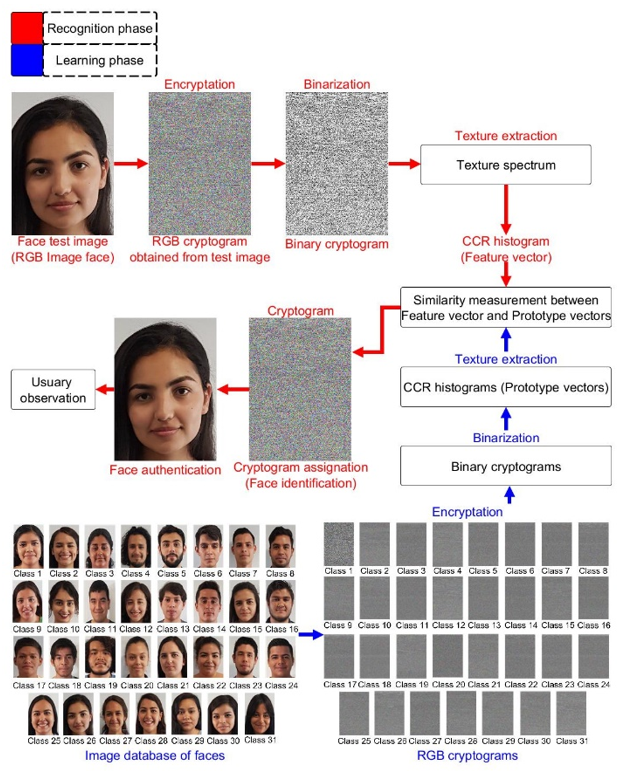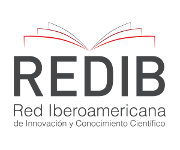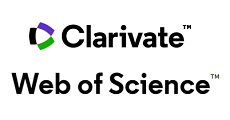
Published
Clasificación de criptogramas faciales a través de sus características de textura local
Facial Cryptograms Classification through their Local Texture Features
DOI:
https://doi.org/10.15446/ing.investig.106069Keywords:
reconocimiento facial, eficiencia de la clasificación, caos, criptografía, representación de cluster coordinado, características texturales locales (es)facial recognition, classification efficiency, chaos, cryptography, coordinated clusters representation, local textural features (en)
Downloads
Con el uso creciente de las redes sociales, personas no autorizadas han conseguido detectar o interceptar datos personales, que podrían utilizarse de manera inapropiada, causando así daños personales. Por lo tanto, es esencial utilizar un mecanismo de seguridad que ayude a proteger la información de ataques maliciosos. En este trabajo se propone el reconocimiento facial, utilizando las características texturales locales de los criptogramas. Se cifraron imágenes faciales en formato Red-Green-Blue (RGB) aplicando el modelo matemático de Mapa Logístico, lo que generó un criptograma. Las características texturales locales de estos criptogramas se extrajeron mediante la transformación de representación de cluster coordinado (CCR). La alta eficiencia de clasificación (97-100%) de las imágenes faciales cifradas fue validada experimentalmente utilizando dos bases de datos: la primera fue generada controlando parámetros como la rotación, escala e iluminación; y la segunda es una base de datos pública. Esta técnica es adecuada para una amplia gama de aplicaciones relacionadas con la autenticación de usuarios, y protege la identidad de los usuarios autorizados cuando se acompaña de capas adicionales de seguridad que involucran imágenes de interés, como las utilizadas en el campo médico, mejorando la seguridad de los usuarios cuyas enfermedades se estudian gráficamente en los hospitales. Además, esta técnica puede desplegarse para proteger lanzamientos de nuevos productos donde las imágenes son importantes, como ropa, calzado, mosaicos, etc., ya que no es necesario descifrar las imágenes para clasificarlas.
With the increasing use of social networks, unauthorized individuals have become able to detect or intercept personal data, which could be used improperly, thereby causing personal damage. Therefore, it is essential to utilize a security mechanism that aids in protecting information from malicious attacks. In this work, facial recognition is proposed, using the local textural features of cryptograms. Red-Green-Blue (RGB) facial images were encrypted by applying the mathematical Logistic Map model, which generated a cryptogram. These cryptogram’s local textural features were extracted via Coordinated Cluster Representation (CCR) transform. The high classification efficiency (97-100%) of the encrypted facial images was experimentally validated using two databases: the first one was generated by controlling parameters such as rotation, scale, and lighting; and the second one is a public database. This technique is suitable for a wide range of applications related to user authentication, and it safeguards the identity of authorized users when accompanied by additional layers of security involving images of interest, such as those employed by the medical field, enhancing the security of users whose diseases are graphically studied in hospitals. In addition, this technique can be deployed to protect new product launches where images are important, such as clothing, footwear, mosaics, etc., since one does not need to decrypt the images in order to classify them.
References
Afifi, A. (2019). A chaotic confusion-diffusion image encryption based on Henon map. International Journal of Network Security & Its Applications, 11(4), 19-30. https://doi.org/10.5121/ijnsa.2019.11402
Aguilar Santiago, J., Flores Siordia, O., Guillen Bonilla, J. T., Estrada Gutiérrez, J. C., González Novoa, M. G., and Jiménez Rodríguez, M. (2020). Chaotic cryptosystem for selective encryption of faces in photographs. Security and Communication Networks, 2020, 1-22. https://doi.org/10.1155/2020/8848356
Ahmad Khan, F., Bouridane, A., Boussakta, S., Jiang, R., and Almaadeed, S. (2021). Secure facial recognition in the encrypted domain using a local ternary pattern approach. Journal of Information Security and Applications, 59, 102810. https://doi.org/10.1016/j.jisa.2021.102810
Alaei, F., Alaei, A., Pal, U., and Blumenstein, M. (2019). A comparative study of different texture features for document image retrieval. Expert Systems with Applications, 121, 97-114. https://doi.org/10.1016/j.eswa.2018.12.007
Bansal, P., Mittal, S., and Gupta, M. (2014). Using Locality Preserving Projections in Face Recognition. 2(3), 99-108. https://api.semanticscholar.org/CorpusID:212515605
Bello-Cerezo, R., Bianconi, F., Di Maria, F., Napoletano, P., and Smeraldi, F. (2019). Comparative evaluation of hand-crafted image descriptors vs. off-the-shelf CNN-based features for colour texture classification under ideal and realistic conditions. Applied Sciences, 9(4), 738. https://doi.org/10.3390/app9040738
Carlos Eduardo Thomaz—Personal Web Page (n.d.). https://fei.edu.br/~cet/facedatabase.html
Dunn, J. C. (1973). A fuzzy relative of the ISODATA process and its use in detecting compact well-separated clusters. Journal of Cybernetics, 3(3), 32-57. https://doi.org/10.1080/01969727308546046
fliphtml5.com (n.d.). 4243_0819_rp_qtrly-threats-aug-2019_lores. https://fliphtml5.com/rshui/bhkw/4243_0819_rp_qtrly-threats-aug-2019_lores/
Gao, S., Wu, R., Wang, X., Liu, J., and Li, Q. (2023a). EFR-CSTP: Encryption for face recognition based on the chaos and semi-tensor product theory. Information Sciences, 621, 766-781. https://doi.org/10.1016/j.ins.2022.11.121
Gao, S., Wu, R., Wang, X., Liu, J., Li, Q., Wang, C., and Tang, X. (2023b). Asynchronous updating boolean network encryption algorithm. IEEE Transactions on Circuits and Systems for Video Technology, 33(8), 4388-4400. https://doi.org/10.1109/TCSVT.2023.3237136
Gao, S., Wu, R., Wang, X., Wang, J., Li, Q., Wang, C., and Tang, X. (2023c). A 3D model encryption scheme based on a cascaded chaotic system. Signal Processing, 202, 108745. https://doi.org/10.1016/j.sigpro.2022.108745
Guillen-Bonilla, J. T., Kurmyshev, E., and Fernández, A. (2007). Quantifying a similarity of classes of texture images. Applied Optics, 46(23), 5562. https://doi.org/10.1364/AO.46.005562
Ibrahim, D. R., Abdullah, R., and Teh, J. S. (2021). Multifactor authentication system based on color visual cryptography, facial recognition, and dragonfly optimization. Information Security Journal: A Global Perspective, 30(3), 149-159. https://doi.org/10.1080/19393555.2020.1817633
Ibrahim, D. R., Abdullah, R., Teh, J. S., and Alsalibi, B. (2019). Authentication for ID cards based on colour visual cryptography and facial recognition [Conference presentation]. 3rd International Conference on Cryptography, Security and Privacy. https://doi.org/10.1145/3309074.3309077
Jiménez-Rodríguez, M.., Flores-Siordia, O., and González-Novoa, M. G. (2015). Sistema para codificar información implementando varias órbitas caóticas. Ingeniería, Investigación y Tecnología, 16(3), 335-343. https://doi.org/10.1016/j.riit.2015.05.004
Jiménez-Rodríguez, M., Padilla Leyferman, C. E., Estrada Gutiérrez, J. C., González Novoa, M. G., Gómez Rodríguez, H., and Flores Siordia, O. (2018). Steganography applied in the origin claim of pictures captured by drones based on chaos. Ingeniería e Investigación, 38(2), 61-69. https://doi.org/10.15446/ing.investig.v38n2.64509
Kalech, M. (2019). Cyber-attack detection in SCADA systems using temporal pattern recognition techniques. Computers & Security, 84, 225-238. https://doi.org/10.1016/j.cose.2019.03.007
Kumar, V., and Girdhar, A. (2021). A 2D logistic map and Lorenz-Rossler chaotic system based RGB image encryption approach. Multimedia Tools and Applications, 80(3), 3749-3773. https://doi.org/10.1007/s11042-020-09854-x
Kurmyshev, E. V., and Cervantes, M. (1996). A quasi-statistical approach to digital binary image representation. International Journal of e-Navigation and Maritime Security, 42(1), 104-116. https://doi.org/10.1016/j.enavi.2017.05.007
Kurmyshev, E. V., Poterasu, M., and Guillen-Bonilla, J. T. (2007). Image scale determination for optimal texture classification using coordinated clusters representation. Applied Optics, 46(9), 1467. https://doi.org/10.1364/AO.46.001467
Kurmyshev, E. V., and Sánchez-Yáñez, R. E. (2005). Comparative experiment with colour texture classifiers using the CCR feature space. Pattern Recognition Letters, 26(9), 1346-1353. https://doi.org/10.1016/j.patrec.2004.11.028
Leyferman, C. E. P., Bonilla, J. T. G., Gutiérrez, J. C. E., and Rodríguez, M. J. (2023). A novel technique for texture description and image classification based in RGB compositions. IET Communications, 17(10), 1162-1176. https://doi.org/10.1049/cmu2.12601
Luo, X., Xu, Y., and Yang, J. (2019). Multi-resolution dictionary learning for face recognition. Pattern Recognition, 93, 283-292. https://doi.org/10.1016/j.patcog.2019.04.027
Mohan, J., and R., R. (2021). Enhancing home security through visual cryptography. Microprocessors and Microsystems, 80, 103355. https://doi.org/10.1016/j.micpro.2020.103355
Nanni, L., Brahnam, S., and Lumini, A. (2019). Texture descriptors for representing feature vectors. Expert Systems with Applications, 122, 163-172. https://doi.org/10.1016/j.eswa.2018.12.052
Pan, H., Lei, Y., and Jian, C. (2018). Research on digital image encryption algorithm based on double logistic chaotic map. EURASIP Journal on Image and Video Processing, 2018(1), 142. https://doi.org/10.1186/s13640-018-0386-3
Peng, C., Wang, N., Li, J., and Gao, X. (2019). DLFace: Deep local descriptor for cross-modality face recognition. Pattern Recognition, 90, 161-171. https://doi.org/10.1016/j.patcog.2019.01.041
Ren, L., and Zhang, D. (2022). A privacy-preserving biometric recognition system with visual cryptography. Advances in Multimedia, 2022, 1-7. https://doi.org/10.1155/2022/1057114
Rodríguez, M. J., González-Novoa, M. G., Estrada-Gutiérrez, J. C., Acosta-Lúa, C., and Flores-Siordia, O. (2016). Secure point-to-point communication using chaos. DYNA, 83(197), 180. https://doi.org/10.15446/dyna.v83n197.53506
Sánchez-Yáñez, R. E., Kurmyshev, E. V., and Cuevas, F. J. (2003). A framework for texture classification using the coordinated clusters representation. Pattern Recognition Letters, 24(1-3), 21-31. https://doi.org/10.1016/S0167-8655(02)00185-X
Shi, L., Song, X., Zhang, T., and Zhu, Y. (2019). Histogram-based CRC for 3D-aided pose-invariant face recognition. Sensors, 19(4), 759. https://doi.org/10.3390/s19040759
Suman, R. R., Mondal, B., and Mandal, T. (2022). A secure encryption scheme using a composite logistic sine map (CLSM) and SHA-256. Multimedia Tools and Applications, 81(19), 27089-27110. https://doi.org/10.1007/s11042-021-11460-4
Wu, R., Gao, S., Wang, X., Liu, S., Li, Q., and Erkan, U. (2022). AEA-NCS: An audio encryption algorithm based on a nested chaotic system. Chaos, Solitons & Fractals, 165, 112770. https://doi.org/10.1016/j.chaos.2022.112770
Xiang, H., and Liu, L. (2020). An improved digital logistic map and its application in image encryption. Multimedia Tools and Applications, 79(41-42), 30329-30355. https://doi.org/10.1007/s11042-020-09595-x
Yang, J., Wang, X., Han, S., Wang, J., Park, D. S., and Wang, Y. (2019). Improved real-time facial expression recognition based on a novel balanced and symmetric local gradient coding. Sensors, 19(8), 1899. https://doi.org/10.3390/s19081899
Zhang, L., Yang, M., Feng, X., Ma, Y., and Zhang, D. (2014). Collaborative representation based classification for face recognition. https://doi.org/10.48550/arXiv.1204.2358
How to Cite
APA
ACM
ACS
ABNT
Chicago
Harvard
IEEE
MLA
Turabian
Vancouver
Download Citation
License
Copyright (c) 2024 Maricela Jiménez Rodríguez, José Trinidad Guillen Bonilla, Jorge Aguilar Santiago, Juan Carlos Estrada Gutiérrez

This work is licensed under a Creative Commons Attribution 4.0 International License.
The authors or holders of the copyright for each article hereby confer exclusive, limited and free authorization on the Universidad Nacional de Colombia's journal Ingeniería e Investigación concerning the aforementioned article which, once it has been evaluated and approved, will be submitted for publication, in line with the following items:
1. The version which has been corrected according to the evaluators' suggestions will be remitted and it will be made clear whether the aforementioned article is an unedited document regarding which the rights to be authorized are held and total responsibility will be assumed by the authors for the content of the work being submitted to Ingeniería e Investigación, the Universidad Nacional de Colombia and third-parties;
2. The authorization conferred on the journal will come into force from the date on which it is included in the respective volume and issue of Ingeniería e Investigación in the Open Journal Systems and on the journal's main page (https://revistas.unal.edu.co/index.php/ingeinv), as well as in different databases and indices in which the publication is indexed;
3. The authors authorize the Universidad Nacional de Colombia's journal Ingeniería e Investigación to publish the document in whatever required format (printed, digital, electronic or whatsoever known or yet to be discovered form) and authorize Ingeniería e Investigación to include the work in any indices and/or search engines deemed necessary for promoting its diffusion;
4. The authors accept that such authorization is given free of charge and they, therefore, waive any right to receive remuneration from the publication, distribution, public communication and any use whatsoever referred to in the terms of this authorization.


























